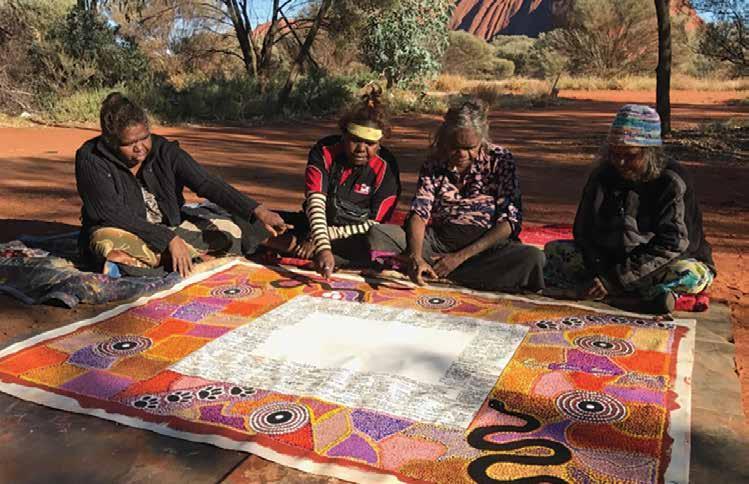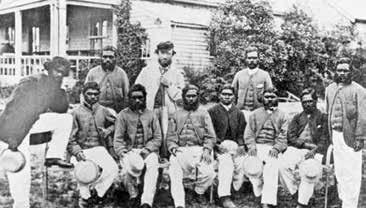
6 minute read
History
Truth Telling
Barry Clark
Advertisement
Bribie Island Historical Society
MORE BRIBIE HISTORY
The next Historical Society meeting is Wednesday 13 JULY at 6;30 pm at the RSL Club.
when our guest speaker will tell the history of the Caboolture Historical Village You can see more Bribie history on our new Web Site Bribiehistoricalsociety. org.au and our Blog Site http://bribieislandhistory. blogspot.com or contact us on bribiehistoricalsociety@ gmail.com
our ORIGINAL HISTORY
FIRST EXPLORERS
Portuguese explorer Ferdinand Magellan was the first person to sail around the world in 1521, going west from Europe to Asia, and naming the Pacific Ocean, but did not see this great southern continent before being killed with a poison arrow in the Philippines. More than 100 years later in 1642, Dutchman Abel Tasman sailed all around this huge continent, but saw only the tip of what he named Van Diemen’s Land, now Tasmania. Two years later he named the north coast of the continent New Holland, and many other explorers over the next 120 years were wrecked on the vast coastline, but there is no record of anyone claiming the east coast until James Cook in 1770. During that period the British East India Company became the words biggest business, controlling 26% of the world’s population and trade for 200 years, making the British Empire the world’s largest monopoly. It took a long time for Europeans to discover this great south land.
INITIAL CONTACT
When early explorers made first contact with the ‘natives” of this land they found Aboriginal society very different, and beyond their comprehension. English explorer William Dampier sailed the northwest coast in 1688, describing the people as “the most miserable people in the world”, because as far as he could see they had no houses, did not use metal, and did not farm or worship anything. Explorers could not appreciate the unfamiliar landscapes and radically different way of life, nor could they see that indigenous people had successfully modified and managed the landscape to provide food and resources throughout 60,000 years of change.
CIVILISATION
The concept of “civilization” for societies with constructed monuments, systems of writing and agriculture came into the English language to describe cultures such as Egyptian, Greek and Roman. Theories about human development, natural selection and a hierarchy of races also developed around that time, using terms such as “Primitive” and “Stone Age”. By the early 1900’s modern science began to reveal the complexity of indigenous Australian society, and realise that the first people had come by sea from what is now Indonesia, over 60,000 years ago, and described the first residents as having:
"Made the first ocean crossing in the history of mankind, performed the oldest human cremations on earth, revered the afterlife before anyone else, dug the oldest mines, painted the largest art galleries, and were the first to depict human faces, paint battle scenes, make axes and tools, and have the longest oral histories and oldest continuous culture on earth."
For the convenience and purpose of British settlement, the new south land was declared to be “Terra Nullius” (nobody’s land) based on limited contact. It is now estimated that when the First Fleet arrived, the indigenous population would have been at least one million people.
TERRA NULLIUS
The Indigenous population rapidly declined due to introduced diseases, violence, frontier wars, social dislocation, loss of traditional land and ecological imperialism caused by the introduction of new animals and plants. Government policies and laws assumed that indigenous Australians would soon die out, and that mixed race people would be gradually assimilated into white society. In 1973 the British Museum mounted an Exhibition of Mankind in which it noted.
In parts of Australia, the aboriginal culture has been extinct for more than a century. The assimilation of the aborigines in proceeding but with varying degrees of success. This was far from the truth, but it was a view long held in some quarters of Australian society, as it was at the start of colonization. It took more than 200 years after white invasion, before the Australian legal system in the High Court Mabo decision in 1992, overturned the assumption that the land belonged to no one.
TRUTH TELLING
We have started making slow progress towards recognition and acceptance of truth telling that is sought in the “Uluru
Statement from the heart”,
asking Australians to walk together to build a better future, establish a First Nations voice in Parliament, and a commission for treaty making and truth telling. Initial steps have been taken saying “Sorry” and the routine recognition of “Elders and Country” in public speeches and the media. There is still much to be done to accept “Truth Telling” of many dark aspects of our history. I have done my share of global exploration. I drove and old car and rode a motorcycle for a couple of years overland from UK to Australia, where my first job as a young Civil Engineer was among the Yirrkala people in remote Arnhem Land.
FIRST LAND RIGHTS
In 1931 Arnhem land was declared an Aboriginal reserve, and the Methodist Church soon established a Mission at remote YIRRKALA on the remote east coast of Arnhem land. In 1963 the Government stole 300 square kilometers of land from these people and granted a lease to Nabalco to develop a massive Bauxite Mine and Alumina Treatment plant. The local Aboriginal people were outraged and handed the first Land Rights Petition to the Government on a piece of tree bark. This was first ever native title litigation case, which was rejected by the Court in 1968. 1968 was the year I arrived as young engineer at what is now Nhulunbuy, on the Gove peninsula, as the Planning Engineer for Nabalco. I lived four years among the indigenous people, constructing a massive mine and treatment plant. It was my first encounter with indigenous Australians, and they taught me a great deal about life and survival in the remote tropical bush. We faced many engineering challenges involving the destruction of sacred trees, rocks and locations that had been the subject of the Bark Petition. I confess now to having little understanding or ability to do anything about it.
PERSONAL LEARNING
What I have come to appreciate in the 50+
years since then are the amazing cultural displays, artistic creations, paintings, woodwork, and carvings of the Yirrkala people that I experienced in those years, were are amongst the most highly regarded of all indigenous art in Australia. I enjoyed the friendship and help of many indigenous people teaching me to catch Fish, Turtle, Dugong, Shark and even Crocodile. In return I shared some of my cold beer with them. What a big mistake I now realise that was, for which I personally say “Sorry”.
AUSSIE CRICKET
I will finish this article with a story about the first indigenous people to gain widespread public awareness overseas. It was a team of 13 Aboriginal cricketers who toured the UK in 1868. That was 154 years ago, when the very first Australian cricket team went to the UK, many years before any first white cricket team went. They played matches against teams in many English towns, where it was a novelty attracting large crowds, as it was just a few years after the publication of Darwin’s “Origin of Species”. Before and after cricket matches, they gave displays of their traditional skills, throwing Boomerangs, and dodging Spears, Clubs and Cricket Balls.









